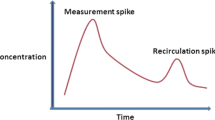Abstract
Purpose: CO2 angiography is considered dangerous in the aortic arch where bubbles may cause critical cerebral and cardiac ischemia. We investigated CO2 distribution, physiologic effects in the heart, methods of detection and treatments. Methods: Eight pigs had CO2 and iodinated contrast arch angiograms in supine and both lateral decubitus positions. An electrocardiogram, physiologic data and cardiac ultrasound were obtained. Therapies included precordial thumps and rolls to lateral decubitus positions. Results: Supine high descending aorta CO2 injections floated retrograde up the arch during diastole and preferentially filled the right coronary artery (RCA): mean score 3.5 (of 4), innominate artery 2.4, left coronary artery 1.2; n = 17; p = 0.0001. Aortic root injections preferentially filled the RCA when the animal was supine, left coronary in the right decubitus position, and showed a diffuse pattern in the left decubitus position. Right decubitus rolls filled both coronaries causing several lethal arrhythmias. Precordial thumps successfully cleared CO2. Ultrasound is a sensitive detector of myocardial CO2. Conclusion: Arch distribution of CO2 primarily involves the RCA. Diagnostic ultrasound detects cardiac CO2 well. Precordial thumps are an effective treatment.






Similar content being viewed by others
References
SR Kerns IF Jr. Hawkins (1995) ArticleTitleCarbon dioxide digital subtraction angiography: Expanding applications and technical evolution. AJR Am J Roentgenol 164 735–741 Occurrence Handle7863904
I Hawkins J Caridi S Kerns (1995) ArticleTitlePlastic bag delivery system for hand injection of carbon dioxide. AJR Am J Roentgenol 165 1487–1489
IF Hawkins JG Caridi SD Klioze CR Mladinich (2001) ArticleTitleModified plastic bag system with O-ring fitting connection for carbon dioxide angiography. AJR Am J Roentgenol 176 229–232
ST Hahn T Pfammatter KJ Cho (1995) ArticleTitleCarbon dioxide gas as a venous contrast agent to guide upper-arm insertion of central venous catheters. Cardiovasc Intervent Radiol 18 146–149 Occurrence Handle7648588
R Boyd-Kranis KL Sullivan DJ Eschelman J Bonn GA Gardiner (1999) ArticleTitleAccuracy and safety of carbon dioxide inferior vena cavography. J Vasc Interv Radiol 10 1183–1189
IF Jr Hawkins JG Caridi (1999) ArticleTitleFine needle transjugular intrahepatic portosystemic shunt procedure with CO2. AJR Am J Roentgenol 173 625–629 Occurrence Handle10470891
Y Rolland R Duvauferrier A Lucas C Gourlay N Morcet M Rambeau J Chaperon (1998) ArticleTitleLower limb angiography: A prospective study comparing carbon dioxide with iodinated contrast material in 30 patients. AJR Am J Roentgenol 171 333–337 Occurrence Handle9694446
J Caridi I Hawkins (1997) ArticleTitleCO2 digital subtraction angiography: Potential complications and their prevention. J Vasc Interv Radiol 8 383–391 Occurrence Handle1:STN:280:ByiB1MjksVY%3D Occurrence Handle9152911
J Rundback P Shah J Wong SC Babu G Rozenblit MR Poplausky (1997) ArticleTitleLivedo reticularis, rhabdomyolysis, massive intestinal infarction, and death after carbon dioxide arteriography. J Vasc Surg 26 337–340 Occurrence Handle9279324
WC Culp T McCowan T Goertzen T Habbe (1998) ArticleTitleCO2 angiography: Complications and pseudocomplications (letter). J Vasc Interv Radiol 10 100–101
WC Culp T Goertzen T McCowan T Habbe M Hummel (1999) ArticleTitlePatient intolerance of CO2 angiography. (letter). AJR Am J Roentgenol 173 240–241
DJ Spinosa AH Matsumoto JF Angle KD Hagspiel TN Hooper (1998) ArticleTitleTransient mesenteric ischemia: A complication of CO2 angiography. J Vasc Interv Radiol 9 561–564 Occurrence Handle9684823
AJ Wilson MM Boxer (1998) ArticleTitleSafety of carbon dioxide as a contrast medium in cerebral angiography. Acad Radiol 5 IssueIDSuppl 1 S51–S53 Occurrence Handle9561043
PB Dimakakos T Stefanopoulos AG Doufas M Papasava A Gouliamos D Mourikis H Deligiorgi (1998) ArticleTitleThe cerebral effects of carbon dioxide during digital subtraction angiography in the aortic arch and its branches in rabbits. AJNR Am J Neuroradiol 19 261–266 Occurrence Handle9504475
U Linstedt J Link M Grabener W Kloess (1997) ArticleTitleEffects of selective angiography of the carotid artery with CO2 on electroencephalogram somatosensory evoked potentials and histopathologic findings: A pilot study in pigs. Invest Radiol 32 507–510 Occurrence Handle10.1097/00004424-199709000-00002
R Coffey RG Quisling JP Mickle IF Hawkins WB Ballinger (1984) ArticleTitleThe cerebral effects of intraarterial CO2 in quantities required for diagnostic imaging. Radiology 151 405–410 Occurrence Handle6424174
KO Ehrman TE Taber GM Gaylord PB Brown JP Hague (1994) ArticleTitleComparison of diagnostic accuracy with carbon dioxide versus iodinated contrast material in the imaging of hemodialysis access fistulas. J Vasc Interv Radiol 5 771–775 Occurrence Handle8000128
CR Lambert EJ de Marchena M Bikkina BK Arcement (1996) ArticleTitleEffects of intracoronary carbon dioxide on left ventricular function in swine. Clin Cardiol 19 461–465 Occurrence Handle8790949
ML Melany EG Grant (1997) ArticleTitleClinical experience with sonographic contrast agents. Semin Ultrasound CT MRI 18 3–12
. Anon. (1998) The guide for the care and use of laboratory animals National Academy Press Washington, DC
CM Muth ES Shank (2000) ArticleTitleGas embolism. N Engl J Med 342 476–482 Occurrence Handle1:STN:280:DC%2BD3c7isFSksA%3D%3D Occurrence Handle10675429
G Caldwell G Millar E Quinn R Vincent DA Chamberlain (1985) ArticleTitleSimple mechanical methods for cardioversion: Defense of the precordial thump and cough version. Br Med J Clin Res 291 627–630
J Miller D Tresch L Horwitz BM Thompson C Aprahamian JC Darin (1984) ArticleTitleThe precordial thump. Ann Emerg Med 13 791–794 Occurrence Handle6476543
RW Yakaitis JS Redding (1973) ArticleTitlePrecordial thumping during cardiac resuscitation. Crit Care Med 1 22–26 Occurrence Handle4757961
M Gertsch S Hottinger T Hess (1992) ArticleTitleSerial chest thumps for the treatment of ventricular tachycardia in patients with coronary artery disease. Clin Cardiol 15 181–188 Occurrence Handle1551266
Author information
Authors and Affiliations
Corresponding author
Rights and permissions
About this article
Cite this article
Culp, W., Porter, T., Culp, W. et al. Carbon Dioxide in the Aortic Arch: Coronary Effects and Implications in a Swine Study . CVIR 26, 128–135 (2003). https://doi.org/10.1007/s00270-002-2623-4
Published:
Issue Date:
DOI: https://doi.org/10.1007/s00270-002-2623-4




